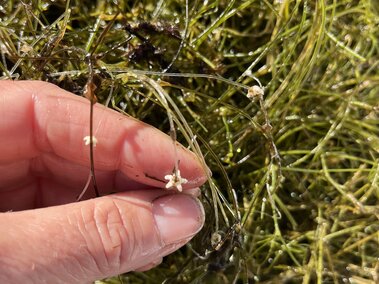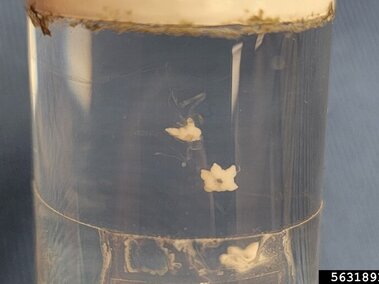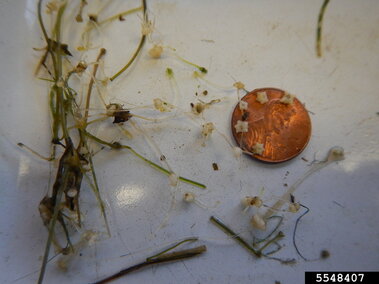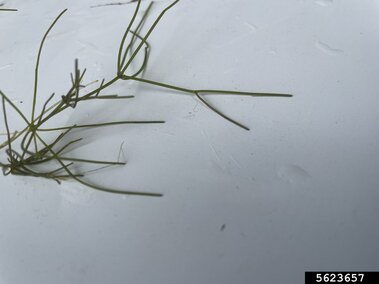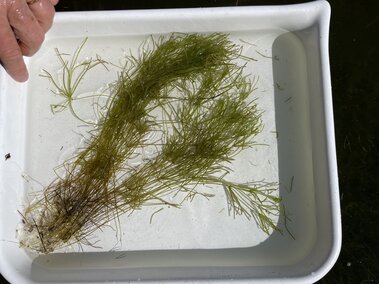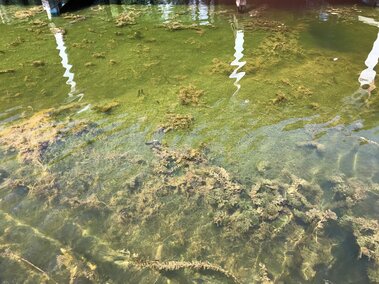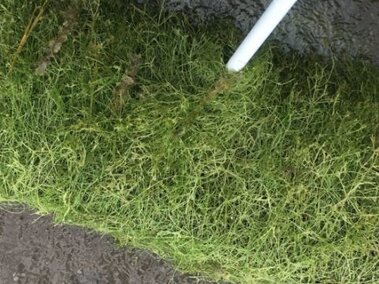General Information
Species Name: Nitellopsis obtusa
Family: Characeae (Stonewort)
Growth Form: Algae
Life Span: Annual
Flowering Dates: July-October
Origin: Eurasia
Noxious: No
Category 1: Potential Aquatic Invasive Species
Why Is It Invasive?
Starry stonewort can create dense mats called “pillows” that can become so thick that they replace native macroalgae, displace aquatic plants and animals, and reduce recreation opportunities, including swimming, boating, and fishing. They directly impact the habitat used by native fish for spawning and reduce light availability for other submersed aquatic plants. It is a highly aggressive competitor that can even outcompete other invasive aquatic plant species.
What Does It Look Like?
General Characteristics
Starry stonewort is a bushy, bright green macro-algae. It produces a characteristic star-shaped bulbil. It produces clear, root-like filaments that anchor it to the sediment.
Flowers
White, star-shaped bulbils (asexual reproductive structures) the size of a grain of rice form on clear threads at the base of the plant and may be found at or below the sediment surface. Small, orange spheres called antheridia (male reproductive structures) may be visible near the tips of the branchlets.
Leaves
Thin, bright green branchlets (branch-like structures) can be variable in length and are arranged in whorls (radiating out from a single point) around the stem. Branchlets typically extend in acute angles away from the stem nodes. Tips of the branchlets may have irregularly lengthed forks or divisions.
Stems
Most stem and branch cells are around 1 mm in diameter, while stems can reach up to 80 cm long.
Seeds
Starry stonewort is a macro-algae, meaning it does not have a vascular system like true plants. Each branchlet or stem is a single cell. Native populations consist of both males and females, but all known introduced populations in North America are male.
Photos
Where Does It Grow?
Starry stonewort grows in freshwater to a depth of over 4 m (13 ft),[1] on soft substrates such as silt, sand and accumulations of detritus. It is sometimes found in deep, slow moving water where other plants are scarce, typically near docks and marinas.
How Does It Spread?
The species was unintentionally introduced into the United States’ Great Lakes through the discharge of contaminated cargo ship ballast water. The first occurrence in the United States was in 1978 along the St. Lawrence River. People spread starry stonewort primarily through the movement of water-related equipment. Fragments can get tangled in trailers, motors, anchors and inside watercrafts (boats, canoes and kayaks). Small bulbils, which may be hidden in mud and debris, can stick to trailer bunks, anchors, ropes, fabric, footwear, as well as scuba, fishing and hunting gear. A small fragment or bulbil can start a new population. It can also be spread within the same waterbody through currents, waves, and recreational activities.
How Do I Control It?
Management of invasive aquatic plants involving either mechanical removal of plants or application of herbicides to public waters requires a permit. Contact the Contact the Nebraska Game and Parks Commission for more information.
Mechanical
Cutting or pulling the plant by hand or with equipment such as rakes or cutting blades could break it into fragments, allowing it to further spread. Contact the Nebraska Game and Parks Commission to determine appropriate removal methods.
Cultural
CLEAN your watercraft, trailer, angling gear and other equipment. Remove all aquatic vegetation and animal species from your equipment.
DRAIN your watercraft at the ramp by removing the boat plug and draining all live wells and ballast tanks.
DRY your watercraft, trailer and other equipment for at least 7 days before visiting another waterbody.
DON'T LET IT LOOSE. Do not release or transport exotic or non-native fish species to new ecosystems, and do not dump aquariums. It is unlawful to release any aquatic species into a waterbody other than the one from which it was harvested. Doing so can promote the spread of AIS.
Chemical
Application of chemicals to public waters requires a permit. Contact the Contact the Nebraska Game and Parks Commission for more information.
What Should I Do If I See It in Nebraska?
If you see starry stonewort in Nebraska, you should report it to the Nebraska Game and Parks Commission's Aquatic Invasive Species (AIS) Program using their AIS Report Form. For guidance on what information to include in your report, check out our reporting tips.
References and More Information
Center for Invasive Species and Ecosystem Health
Minnesota Department of Natural Resources
Nebraska Game and Parks Commission
U.S. Fish & Wildlife Service Ecological Risk Screening Summary

